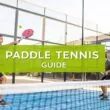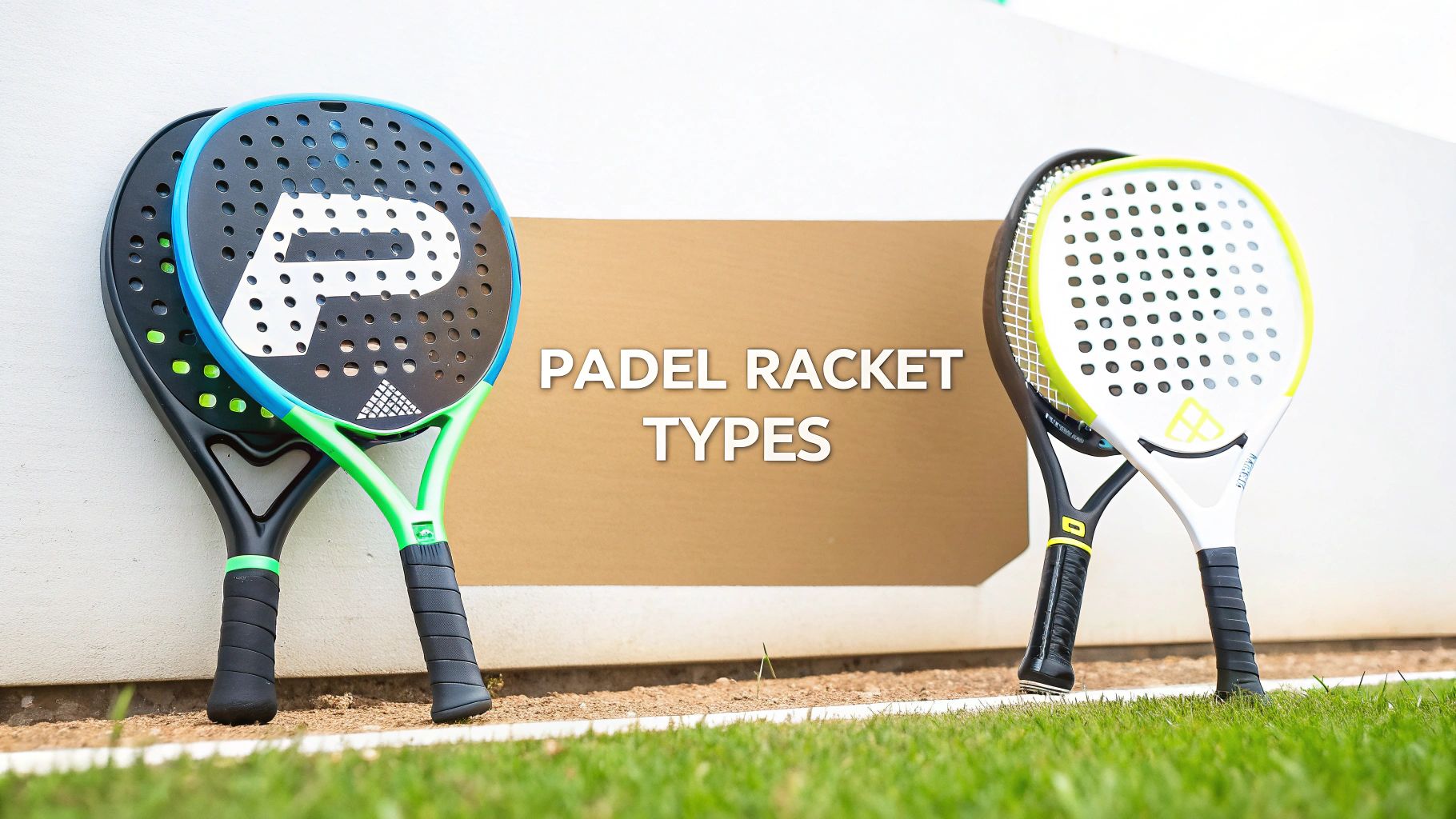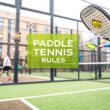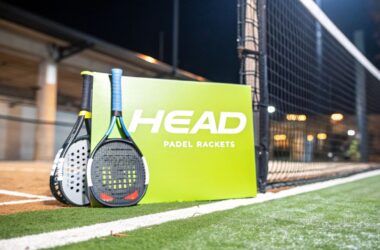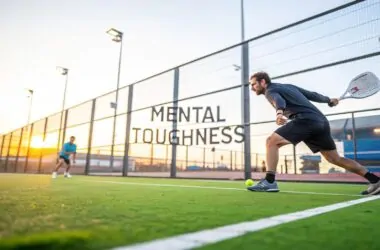Stepping onto a padel court for the first time is a huge thrill, but walking into a shop to buy a racket? That can be downright confusing. The world of padel racket types boils down to three core shapes: Round, Teardrop, and Diamond. Each one is engineered for a completely different style of play, from rock-solid control to explosive power.
Your Guide to Padel Racket Types
Picking your first padel racket is easily the most critical gear decision you'll make. It’s not about finding the coolest-looking one; it's about getting a tool that actually fits your current skill level and helps you build good habits. Think of it like a chef choosing a knife—a delicate paring knife and a heavy cleaver both cut, but you wouldn't use them for the same job.
It’s the same with padel rackets. The shape is everything. It determines the racket's balance, where the "sweet spot" (the most forgiving area to hit the ball) is located, and whether it’s built for defensive placement or all-out attack. Nailing this choice from the start helps you avoid the classic beginner mistake: buying a powerful racket that's way too hard to control.
The Three Foundational Shapes
Every single padel racket fits into one of these three categories. This is the starting point for everyone, from day-one beginners to seasoned pros.
-
Round Rackets: This is where most new players should start. They have a large sweet spot right in the middle, which makes them incredibly forgiving when you don't hit the ball perfectly. It’s all about control.
-
Diamond Rackets: Built for advanced players, these rackets are all about power. The sweet spot is smaller and sits higher up on the face, rewarding players who can consistently hit the ball with precision and force.
-
Teardrop Rackets: This is the versatile, all-around option. Teardrop rackets strike a great balance between power and control, making them a favorite among intermediate players who can do a bit of everything on the court.
Your racket choice should match your current ability, not your ambition. A beginner using an advanced, power-focused racket will likely develop poor form, as they will struggle with control and consistency.
Quick Guide to Padel Racket Shapes
To make things even simpler, here’s a quick-glance table comparing the main padel racket types. It breaks down each shape by what it does best and who it's for.
This little cheat sheet should help you figure out which category fits you best as you start your padel journey. If you want to dive deeper into specific models or see what's new on the market, you can explore the latest padel racket news and reviews.
| Racket Shape | Main Characteristic | Ideal Player Level | Balance Point |
|---|---|---|---|
| Round | Maximum Control & Forgiveness | Beginner | Low (Head-Light) |
| Teardrop | Balanced Power & Control | Intermediate | Medium (Even) |
| Diamond | Maximum Power | Advanced | High (Head-Heavy) |
Hopefully, this gives you a clear picture of where to start your search. Remember, the right racket makes the game more fun and helps you improve faster.
Breaking Down the Three Core Racket Shapes
The shape of a padel racket isn’t just for looks—it’s the blueprint for how it will perform on the court. Every racket has its own personality, and the three core shapes—Round, Diamond, and Teardrop—are each built to deliver a specific mix of power, control, and forgiveness.
Figuring out these differences is the first step to finding a racket that feels less like a piece of equipment and more like a natural extension of your arm.
A simple way to think about it is this: a round racket is like a surgeon’s scalpel, designed for pinpoint precision. A diamond racket is a sledgehammer, built to bring the thunder. And the teardrop? That’s your versatile Swiss Army knife, ready for whatever the match throws at you.
This infographic breaks down the key characteristics of each shape to help you see how they influence gameplay.
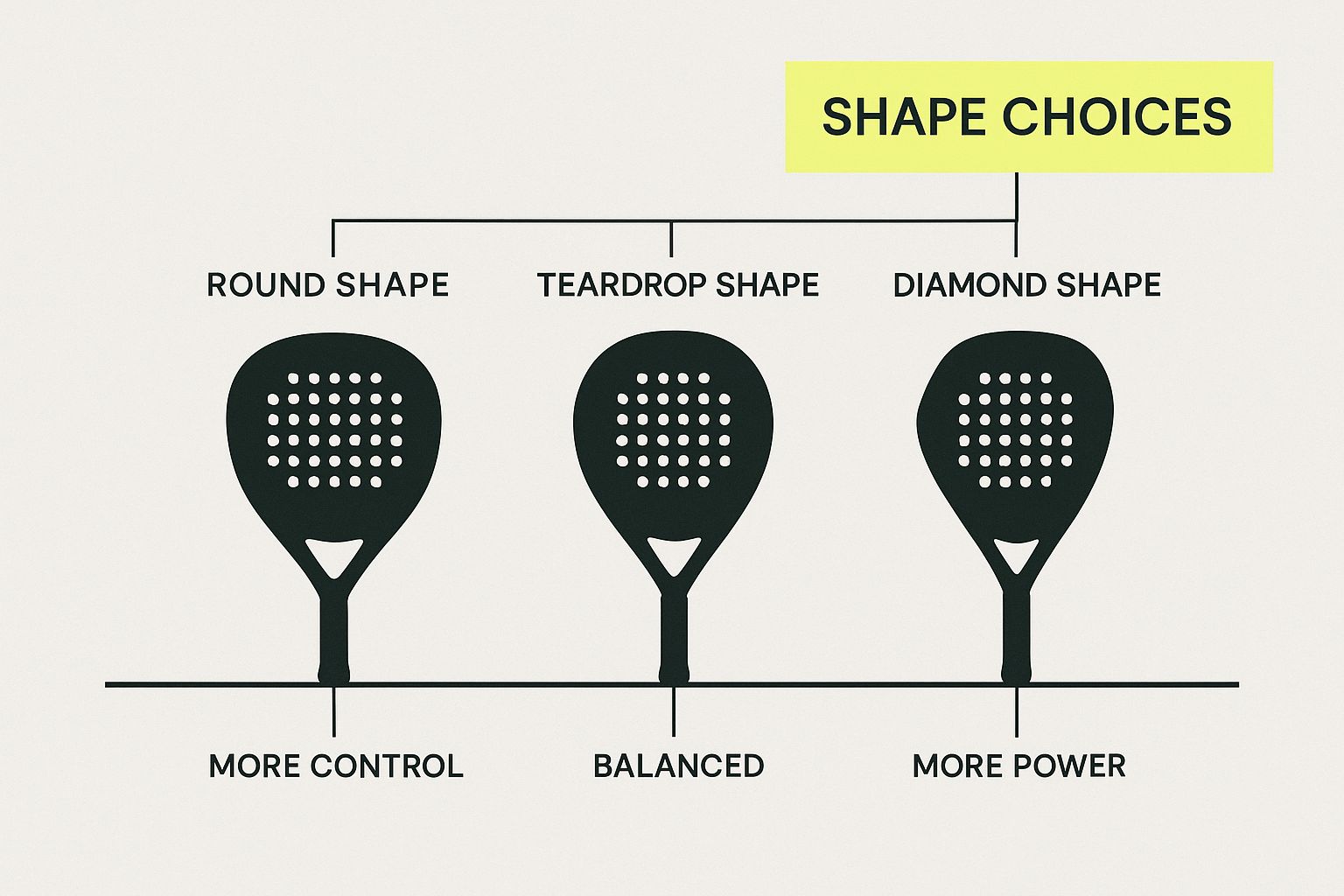
As you can see, the racket's form directly changes its sweet spot and balance, pointing players toward the right choice for their style.
The Round Racket: The Master of Control
The round racket is the undisputed king of control and forgiveness. This makes it the go-to choice for beginners learning the ropes and defensive players who thrive on placement.
Its defining feature is a low balance point, which means the weight is concentrated down near the handle. This makes the racket feel light and incredibly easy to handle, perfect for quick reactions at the net and placing the ball exactly where you want it.
But the real magic of the round shape is its massive, centered sweet spot. This generous hitting area gives you a consistent, predictable response even when you don't strike the ball perfectly. For anyone still developing their technique, that’s a huge confidence booster.
A round racket is designed with one thing in mind: forgiveness. It's built to help you get the ball back over the net consistently, minimize unforced errors, and build a rock-solid defensive game.
This is exactly why almost every coach will put a round racket in a new player's hands. It lets you focus on your form and strategy without getting punished for small mistakes.
The Diamond Racket: The Powerhouse
On the complete opposite end of the spectrum, you’ll find the diamond racket. This thing is built for one job: generating pure, explosive power.
These rackets have a high balance point, shifting most of the weight toward the top of the head. This head-heavy design creates incredible momentum when you swing, which translates into brutal smashes and powerful volleys that can end the point instantly.
Of course, all that power comes with a trade-off. The sweet spot on a diamond racket is much smaller and sits higher up on the face, making it far less forgiving. To really make a diamond racket sing, you need clean technique and precise timing to connect with that small, potent hitting zone every time.
This is why you almost exclusively see diamond rackets in the hands of advanced or professional players. Their game is all about aggression and ending points with authority.
- Who is it for? Advanced players with solid technique who can generate their own control and want to add maximum firepower.
- Key Advantage: Unbeatable power for attacking shots like the vibora and smash.
- Main Drawback: A small, unforgiving sweet spot that harshly punishes off-center hits.
Picking up a diamond racket too early in your padel journey is a recipe for frustration. You'll spend more time trying to control the ball than winning points.
The Teardrop Racket: The All-Rounder
Sitting perfectly between the two extremes is the teardrop racket, often called a hybrid. It’s the most versatile shape of the three, offering a fantastic blend of the best traits from both round and diamond designs.
This balance makes it a massive favorite among intermediate players who’ve nailed the basics and are looking to inject more aggression into their game.
The balance point on a teardrop is usually right in the middle, giving you a great mix of maneuverability and power. The sweet spot is bigger than a diamond's but smaller and slightly higher than a round's, offering a good amount of forgiveness while still rewarding clean shots with serious pace. It's the perfect weapon for the all-court player—someone who can defend with precision and attack with confidence.
The global padel market has embraced these three shapes as the industry standard for classifying rackets by player level. The market segments rackets primarily by shape, with each catering to different styles. Round rackets are favored by beginners, while teardrop and diamond shapes are preferred by intermediate and professional players looking for more power. You can see how these trends influence racket design by checking out more market insights on MaximizeMarketResearch.com.
How Racket Balance and Weight Shape Your Game
Beyond the obvious shape of different padel racket types, there are two invisible forces that truly dictate how a racket feels in your hand and behaves on the court: balance and weight. Getting a handle on these is just as crucial as picking the right shape, as they fine-tune the racket’s personality, tweaking the relationship between raw power and pinpoint control.
When you get this combination right, the racket stops feeling like a tool and starts feeling like an extension of your arm.
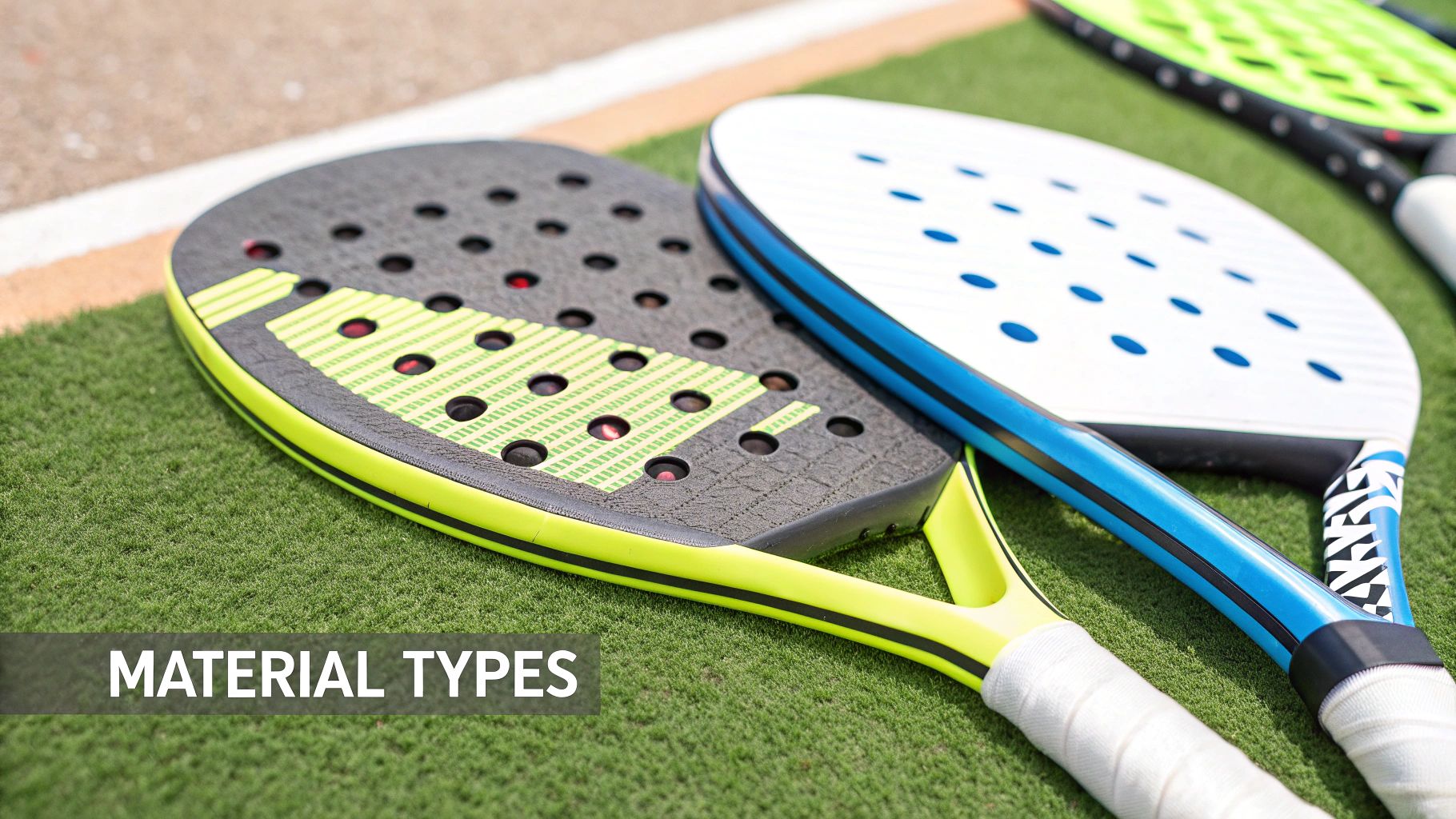
Picture a seesaw. The racket's balance point is the pivot point—the spot where all the weight is perfectly even. Shifting this point closer to the head or the handle completely changes the racket's behavior during a swing, impacting everything from the power of your smash to how fast you can react at the net.
Understanding the Three Balance Points
A racket's balance is a direct result of its shape, but it’s something you feel the moment you pick it up. Each balance type is engineered to boost a specific playing style, either by cranking up the power or maximizing agility.
- Head-Heavy Balance: This is the signature of Diamond rackets. All the weight is shifted toward the top, turning the racket into a sledgehammer. It adds a ton of momentum to your swing, perfect for generating explosive power on smashes and volleys. If you're an aggressive player looking to end points with authority, this is your weapon of choice.
- Head-Light Balance: Typically found in Round rackets, this setup keeps the weight concentrated near the handle. This makes the racket feel incredibly nimble and easy to whip around, giving you lightning-fast reactions for defensive plays and quick-fire exchanges at the net.
- Even Balance: The calling card of Teardrop rackets, offering the best of both worlds. It strikes a perfect compromise between power and control, making it a super versatile option for all-around players who like to mix up their game and adapt on the fly.
The balance point is basically the engine driving a racket's performance. A head-heavy balance creates its own power for you, while a head-light balance gives you the speed and precision to place the ball exactly where you want it.
This explains why a beginner who's struggling to tame a powerful Diamond racket often feels an instant sense of relief when they switch to a head-light Round model. The improved handling lets them focus on their technique instead of wrestling with their gear. To see which models work best for new players, check out our guide on the best padel racket for beginners.
Finding Your Ideal Racket Weight
On top of balance, the racket's overall weight plays a massive part in both performance and injury prevention. Most adult rackets fall into a pretty standard range, but trust me, even a few grams here or there can make a world of difference.
The typical weight for padel rackets is somewhere between 340g and 390g. This spectrum is usually split into two general camps, each with its own pros and cons.
Lighter Rackets (340g – 365g)
Lighter rackets are way easier to swing and handle, which is a huge plus for players still developing their form or those who value speed over brute force.
- Benefit 1: They let you react faster, which is critical when you're defending smashes or getting into a rapid volley battle at the net.
- Benefit 2: They put far less strain on your arm, which seriously cuts down the risk of nasty injuries like tennis elbow.
Heavier Rackets (365g – 390g)
Heavier rackets feel more solid and can definitely generate more power, but they require more physical strength from the player.
- Benefit 1: The extra mass makes them more stable on impact, helping absorb vibrations when you're returning a powerful shot.
- Benefit 2: They transfer more force into the ball, leading to heavier shots—but only if you have a strong, well-developed swing to get them moving.
Ultimately, picking the right weight is a personal call. It all comes down to your physical strength, your technique, and the kind of game you want to play. A lighter racket will help you build control and stay injury-free, while a heavier one can add that extra punch to an already solid game.
2. Decoding Racket Materials and Core Foams
A racket’s materials are its DNA. They're what define its feel, how long it lasts, and ultimately, how it performs on the court. Think of the frame and core as the skeleton and muscles—they determine whether your racket feels soft and forgiving or hard and explosive. Getting a handle on this tech is a game-changer when you're trying to pick the right tool for the job.
Let’s break down the two most important components: the surface material that makes contact with the ball, and the inner foam core that acts as the racket's engine. Once you can translate the technical jargon into what it actually means for your game, you'll be able to read any spec sheet with confidence.
The Face of the Racket: Surface Materials
The face, or surface, is where all the action happens. It's your first point of contact with the ball, and its material dictates the feel of every single shot. The two big players here are Fiberglass and Carbon Fiber, and they couldn't be more different.
-
Fiberglass: This is a more flexible and budget-friendly material, which is why you’ll see it on a lot of beginner and intermediate rackets. Its softness creates a "trampoline effect," helping you launch the ball with less effort. That extra pop is a huge help when you're still dialing in your swing.
-
Carbon Fiber: Stiffer, lighter, and way more durable, carbon fiber is the go-to for advanced rackets. Its rigid nature gives you a direct, crisp feel, which translates to maximum control and power. If you already have a fast swing, carbon fiber rewards your effort with pinpoint precision.
A simple way to think about it: Fiberglass gives you easy power by helping the ball spring off the racket. Carbon Fiber gives you hard power by directly transferring the force from your swing into the ball.
The choice of materials has become a major factor in the market. While fiberglass is great for newcomers looking for a forgiving feel and a lower price point, carbon fiber dominates the professional scene due to its incredible strength-to-weight ratio and stiffness. This is what gives the pros their signature power and precision. You can find more market insights on this trend at StrategicMarketResearch.com.
Understanding Carbon Fiber Grades
When you start looking at higher-end rackets, you'll see terms like 3K, 12K, or 18K carbon. That number just refers to how many carbon filaments are in each thread (3K means 3,000 filaments, 12K means 12,000, and so on).
It’s a common myth that a bigger "K" number automatically means the racket is harder or better. It's actually the opposite. A higher filament count creates a thicker weave, which often results in a slightly more flexible and softer feel on impact.
- 3K Carbon: This is usually the stiffest and gives the most direct response.
- 12K & 18K Carbon: These tend to feel a bit softer and offer more ball output (that trampoline effect) compared to 3K.
But remember, the final feel is also heavily influenced by the resin the manufacturer uses to bind it all together. So, treat the "K" number as a guide, not an absolute rule.
The Engine Room: Racket Core Foams
If the surface is the racket's skin, the core is its heart. This inner foam is the real engine, dictating power, control, and comfort. Nearly every racket core is made from EVA (Ethylene Vinyl Acetate) foam, but it comes in different densities.
The two main types you'll encounter are soft EVA and hard EVA.
Soft EVA Foam
Think of this foam as a comfortable cushion. It absorbs the ball's impact and then springs it back out, creating that familiar trampoline effect for easy power. This makes it perfect for defensive-minded players or beginners who need a little help getting depth on their shots.
Another huge benefit is that it dampens vibrations incredibly well, making it much easier on your arm. It's the top choice for players who are prone to tennis elbow or just want a more comfortable hitting experience.
Hard EVA Foam
Hard EVA is more compact and less flexible. It offers a very direct and responsive feel, giving you superior control if you can generate your own power with fast, aggressive swings.
Advanced players love this stuff because it lets them place the ball with surgical precision and end points with powerful, well-timed smashes. The trade-off? It sends more vibrations up your arm, so it’s less forgiving if you mis-hit the ball.
Now that we've covered the individual components, let's put it all together. The table below gives you a quick-glance comparison of how these materials work and who they're best suited for.
Padel Racket Material Performance Comparison
| Material Component | Type | Primary Benefit | Best For |
|---|---|---|---|
| Surface | Fiberglass | Easy Power & Comfort | Beginners & Intermediate players developing their swing. |
| Surface | Carbon Fiber (3K) | Maximum Control & Hard Power | Advanced players with fast swings seeking precision. |
| Surface | Carbon Fiber (12K+) | Balanced Power & Feel | Intermediate to Advanced players wanting a softer carbon feel. |
| Core | Soft EVA Foam | High Ball Output & Vibration Dampening | Defensive players, beginners, and those with arm sensitivity. |
| Core | Hard EVA Foam | Supreme Control & Direct Response | Aggressive, advanced players who generate their own power. |
Understanding these combinations is key. A hard carbon face with a hard EVA core will be a powerful but demanding racket, while a fiberglass face with a soft EVA core will be forgiving and comfortable. It's all about finding the right mix that complements your style of play.
Matching Your Racket to Your Skill Level
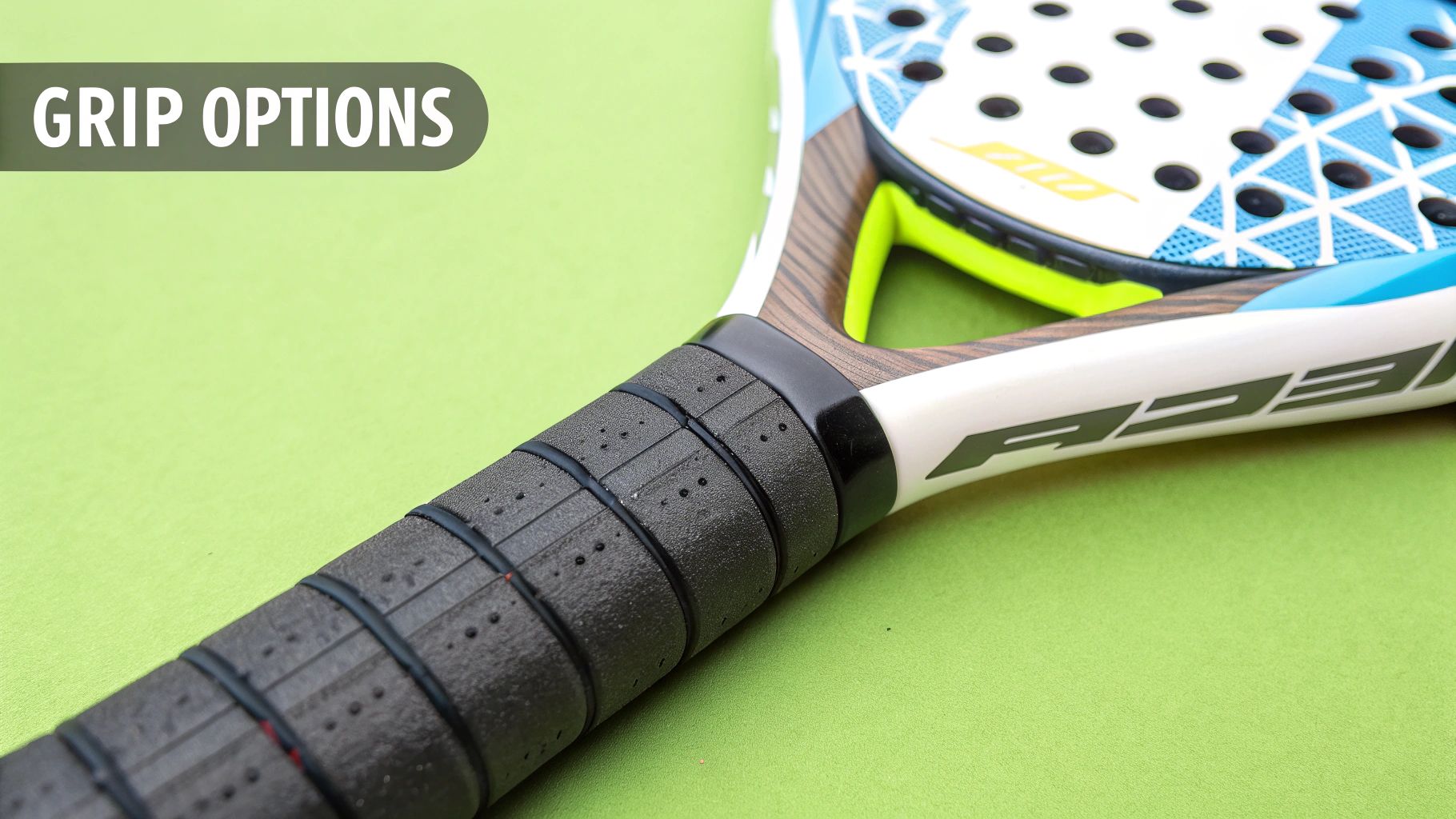
Choosing a padel racket isn't just about grabbing the one with the coolest specs; it's about finding a true partner for your journey on the court. A racket that feels like an extension of a pro's arm will probably feel like a clumsy plank of wood in a beginner's hand.
The trick is to match the racket's DNA—its shape, balance, weight, and materials—to where you are right now with your skills. This guide will help you connect the dots so you can pick a racket that lifts your game up instead of holding it back.
For The Beginner Building a Foundation
Just starting out? Your main goals should be simple: get the ball over the net consistently, develop control, and build a solid technique without getting hurt. The wrong racket can make this whole process a nightmare.
Your first racket should be your most forgiving friend. Look for these key features:
- Shape: A Round shape is non-negotiable. It gives you the biggest, most centered sweet spot possible, which means even your not-so-perfect hits have a good chance of going where you want.
- Weight: Go light. Anything between 340g and 365g is the sweet spot. A lighter racket is way easier to swing, helps you avoid getting tired quickly, and is your best defense against pesky injuries like tennis elbow.
- Core: A soft EVA core paired with a fiberglass face is the perfect starting combo. This setup feels comfortable on impact, soaks up vibrations, and gives you a nice "trampoline" effect to help you get the ball over the net without a huge swing.
Think of a beginner's racket as a tool that does most of the heavy lifting for you. It's built to forgive your mistakes while you focus on learning the fundamentals of control and shot placement.
For The Intermediate Player Adding Aggression
Okay, so you’ve got the basics down. You can rally with confidence and you're starting to think about ending points with a bit more authority. Now you need a racket that can still defend well but also packs a bigger punch when you step forward. This is where hybrid rackets really come into their own.
Here’s what to look for:
- Shape: The Teardrop (or hybrid) shape is your best bet. It strikes a fantastic balance between the control you get from a round racket and the power of a diamond one. The sweet spot is a little higher, giving you more leverage on your attacking shots.
- Balance: An even or medium balance is ideal. It’s maneuverable enough for quick defensive plays at the back wall but has enough weight toward the head to add some real pop to your volleys and smashes.
- Materials: Now’s the time to dip your toes into carbon fiber. Look for rackets with a medium-density EVA core and a face that blends in some carbon fiber (like a 3K weave). This gives you a firmer, more responsive feel without being too punishing.
For The Advanced Competitor Seeking Dominance
At this level, it's all about fine margins, raw power, and pinpoint precision. You've honed your technique and can generate your own pace, so you need a racket that acts like a scalpel—a high-performance tool that rewards your aggressive style.
Your weapon of choice will likely have these traits:
- Shape: Diamond shapes are the standard here. By shifting the sweet spot to the very top of the racket, they maximize leverage and create explosive power, especially on smashes.
- Weight: You’ll be looking at heavier models, usually from 365g to 390g. That extra mass provides the stability you need to hit heavy, penetrating shots that push your opponents back.
- Materials: A hard EVA core and a stiff carbon fiber face (think 12K or 18K) are essential. This combination offers a direct, powerful feel with almost no energy lost at impact—what you put in, you get out.
Making the right call is critical. If you're looking for specific models that fit these profiles, our detailed guide on the best padel rackets is a great place to compare what's out there. At the end of the day, picking a racket that matches your skill level is the surest way to find a tool that helps you win, not one that holds you back.
Common Questions About Padel Rackets
Diving into the world of padel racket types can feel a bit overwhelming. All the talk about materials, shapes, and weights can bring up a lot of questions, especially when you're trying to figure out how those specs actually feel on the court.
We get it. To help clear things up, we’ve put together answers to the most common questions players ask when picking out a racket. Our goal is to help you feel confident you're making the right choice.
How Do I Know When to Upgrade My Padel Racket?
The biggest sign it’s time for a new racket is when you feel like your current one is holding you back. Your racket should be a tool that helps your game, not a limitation.
You should probably start looking for an upgrade if any of these sound familiar:
- Your shots feel weak, even with good technique. If you've moved past the beginner stage, that soft, easy-to-use racket might not be able to translate your improved swing into real power. You might need something stiffer to get more ball speed.
- You're struggling to control your powerful shots. As you start hitting harder, you might find the ball flying more than you'd like. A racket with a harder core or a carbon face will give you the precision you need to tame that power.
- Your game has changed. Maybe you started out as a defensive player who loved a round racket, but now you’re attacking the net more often. Moving to a teardrop racket is a great next step to add some extra punch to your game.
Does a More Expensive Racket Really Make a Difference?
Yes, it absolutely does—but only if your skill level is ready for it. The price tag on a padel racket almost always comes down to the quality of the materials inside it.
Pricey rackets are built with premium stuff like high-grade carbon fiber and specialized EVA foams. For an advanced player, these materials offer a noticeable boost in power, pinpoint control, and much better vibration dampening.
But here’s the catch: these high-performance rackets are usually very stiff. For a beginner, that stiffness is tough to handle, unforgiving when you don't hit the sweet spot, and can even cause arm pain. A new player will have a much better time and learn faster with an affordable, forgiving fiberglass racket than with a pro-level model.
The biggest mistake a beginner can make is buying a racket that's too advanced for them. They see the pros using a power-focused diamond racket and think they need one too, which just leads to frustration and bad habits.
For almost every new player, starting with a lightweight, round-shaped racket is the way to go.
How Much Does Racket Hardness Affect My Game?
Racket hardness has a massive impact on everything you do on the court. It’s determined by the mix of the face material and the core foam, and it directly affects your power, control, and overall comfort.
A soft racket, usually made with fiberglass and a soft EVA core, feels a bit like a cushion. It absorbs the ball's impact and creates a "trampoline effect," which gives you easy power without needing a huge swing. This is perfect for beginners or anyone worried about arm issues like tennis elbow.
On the other hand, a hard racket (think carbon fiber and a hard EVA core) gives you a much more direct and responsive feel. It delivers incredible control and rewards players who have fast, aggressive swings with a ton of power. However, it also sends more vibrations up your arm.
Ultimately, the right choice is all about finding the right balance between the performance you want and the comfort you need.
At Padel Rumors, we bring you the latest news, detailed gear reviews, and expert guides to help you find the perfect equipment for your game. Check out all our resources to stay on top of your game. Visit us at https://www.padelrumors.com.



